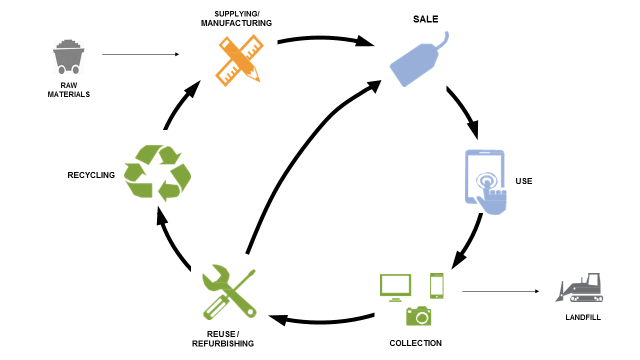Helping Communities Manage Electronic Waste
Published June 1, 2021

Cell phones, televisions, laptops, tablets, watches – there is always something shinier, newer, faster, and smarter to choose from in the world of electronic devices. Americans currently own more than 3 billion electronic products. The average American has 24 devices per household. As the use of these electronic products has grown, the average lifespan of these products becomes shorter. This in turn has resulted in increased volume of discarded and obsolete electronic devices. The resulting waste, commonly known as “e-waste,” is the fastest-growing component of the municipal waste stream in the United States. According to the Global E-Waste Monitor (2017) this has become an emerging problem worldwide, with an estimated 40 million tons of e-waste being generated every year, with less than 30 percent being recycled. The remaining e-waste materials are discarded in landfills or incinerated.
Recovering materials from this waste stream poses challenges. “Management of the electronic waste is related to composition,” said EPA researcher John Glaser. “Separating different items or assemblages should occur early in the recycling pathway. Generally, much more complex mixtures of e-waste materials lead to a situation where material recovery is very limited.”
To help understand and improve the flow of used electronics products from consumer markets to the waste or reuse stream, EPA researchers have developed the Alternative Disposition of Electronics Planning Tool, also called ADEPT.
ADEPT is a modeling tool that uses electronics purchasing data to estimate the composition and quantity of electronic materials designated as waste or reuse. The tool tracks the generation of e-waste on an annual basis for each state and estimates the material flow from end-of-use to disposal. This method uses a market supply method to calculate the amount of e-waste that will be generated, reused, recycled, exported, and disposed of in landfills.
E-waste products may contain valuable materials, such as gold, copper and nickel, and rare materials of strategic value such as indium and palladium. Many of these materials can be recovered and reused, while hazardous materials in e-waste, such as mercury, lead, and brominated flame retardants, may require special disposal.
“The simpler the composition of recycling materials, the easier the task of recycling,” explained Glaser. “Separating items may take additional time and money and may be avoided by a recycling company in search of a profit.”
ADEPT can be used to make predictions of future waste generation demands and to evaluate different disposal scenarios of used electronics at both state and national levels. It can also be a useful tool for states to understand how much and what type of e-waste is being generated in their state. This information can be used to improve existing recycling programs.
“ADEPT was designed to be a flexible tool that can be valuable to many users,” said Glaser. “The utility of ADEPT extends from state regulators to interested people in our communities.”
In the hands of state officials and manufacturers, ADEPT can be used to measure the value of current state takeback programs. Many electronics companies and retailers have voluntary takeback programs where they offer takeback and recycling options for e-waste even in states where there is no law requiring it. Manufactures who participate in the takeback program can use ADEPT to estimate the composition of current and future year’s material in the state takeback program.
If done properly, the United States can increase its domestic recycling efforts, reduce harm from exports of E-Waste, strengthen domestic and international markets for viable and functional used electronic products, and prevent health and environmental threats from e-waste.
ADEPT is part of EPA’s long-term approach towards sustainable electronics stewardship.
Read more about ADEPT access the tool here .
